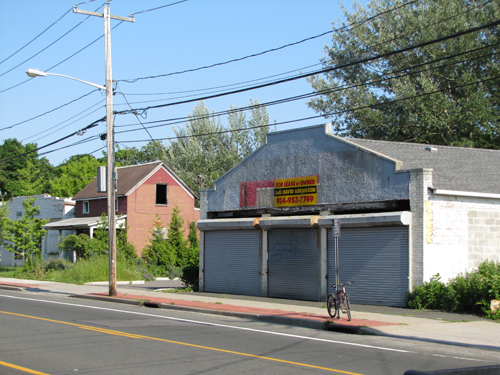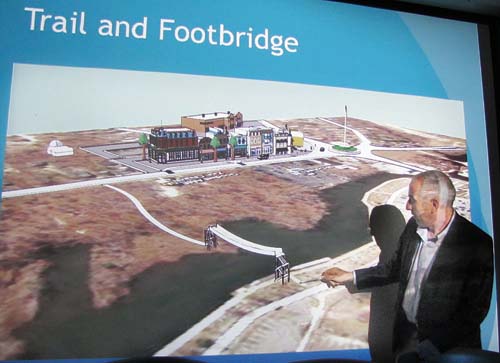Plan for Riverside won’t work without sewers, locals say

A high water table and high number of vacant buildings are among the reasons some Riverside business and property owners give for why it’s been so hard to develop that area of Southampton Town commercially.
Those comments come a week after Suffolk County Legislator Jay Schneiderman (I-Montauk) unveiled a vision for Riverside, including a reconfigured traffic circle, in a 3D computer graphic presentation before the Flanders, Riverside and Northampton Community Association.
The proposal was just a vision, he stressed to the civic members, designed to jump-start a planning process, rather than an actual development proposal.
He suggested that the commercial corridor on Flanders Road, across from McDonald’s, contain two- and three-story buildings with retail shops and cafes on the ground floor and apartments above them.
He likened the plan’s “Main Street” component to downtown Sag Harbor.
Mr. Schneiderman also suggested working with the owners of the Budget Host Inn and the vacant building that once housed the Riverboat Diner to try to reroute Riverleigh Avenue (County Road 104) so it connects to Lake Avenue (County Road 63) instead of extending all the way to the five-pronged traffic circle. Officials would also try to convince the hotel owners to develop that property as a supermarket and try to re-establish a restaurant at the diner site.
The lawmaker said if there is no interest from those property owners, he would support making the traffic circle into a two-lane roundabout that remains connected to the five roads it now serves.
The legislator’s vision, which came out of meeting with civic and town leaders, also featured a walking trail to the Peconic River and a footbridge over the river into downtown Riverhead.
Mr. Schneiderman also stressed nothing could happen without a commercial sewage treatment facility, because of the environmentally sensitive nature of the land along the Peconic River, and he said cooperation from property owners is needed. Now would be a good time to propose such a plan, he said, because many of the buildings in the area are boarded up or for sale.
Shep Scheinberg, whose family owns the Riverboat Diner property, which has sat vacant for several years, said by email that this property is on the market for lease or sale. He said a bank had shown interest in the site but, after hearing a county Department of Public Works presentation on options for improving the flow of traffic in the circle, “they got cold feet, as the state of our property was uncertain.”
Mr. Scheinberg said he and his family have had a number of meetings on this subject with the county and town, the last being on May 31. After that meeting, he said, “it was concluded and agreed by all parties that the option of going through our property was no longer a consideration.”
Because of this, Mr. Schneiderman said, “the county is now reaching out to the owner of the adjacent motel property to see if we can begin a discussion that would redevelop that property as a supermarket and allow the road connection.”
The owner of the Budget Host Inn could not be reached for comment.
David Abrahamson, a co-owner of the former 99 Cent Store across from McDonald’s, said the ownership group is still trying to find a tenant for that building, which has been vacant for about a year and a half.
He said Mr. Schneiderman’s vision for the Flanders Road corridor “would be pretty difficult” without sewer plants.
“One of the issues is the high water table in the area,” he said in an interview. “Anything that comes in there that isn’t dry goods is an issue, because you would need to build an above-ground septic system.”
He said the property is only about one foot above groundwater.
The existing septic system is only good for the sinks and bathrooms, Mr. Abrahamson said. “If you’re preparing foods, you need an above-ground septic system, and that could cost at least $50,000.”
Mr. Schneiderman has secured a $250,000 county grant to study the possibly of building a sewage treatment plant in Riverside that would make it easier to develop properties like Mr. Abrahamson’s. However, the cost of the system isn’t known yet because officials must still decide how large an area would be covered by the proposed sewer district. The smaller the area, the less the district would cost, he said.
William Eves, who owns the building in between the New York State Police barracks and the vacant Getty station on the Riverside traffic circle, said he has town approval for a 15-seat fast food restaurant in that building. He says there has been a lot of interest in leasing the building, but that he wants to sell it. But there hasn’t been as much interest from prospective buyers, he said.
Mr. Eves said he thought the area was rebounding a few years ago but that progress stopped. He feels that being surrounded by vacant building like the former Getty site and the Riverboat Diner site also hurts attempts to redevelop.
And like Mr. Abrahamson, Mr. Eves said the low water table is a major obstacle. His property is about four feet above groundwater and, he says, the area was apparently raised many years ago because there’s a concrete road buried under the current road.
Mr. Eves said he believes the Getty station, which has been closed for about two years, should be torn down. He thinks the previous plan to build a hotel and conference center along the river, as well as a plan from the 1990s for a Long island Maritime Museum, were what the area needed.
The hotel plan, proposed by Southampton Inn owner Dede Gotthelf, ran into environmental issues and Ms. Gotthelf sold much of the land to the county as open space. The Maritime Museum plan, for the same site, never came to fruition.
Mr. Eves also had another proposal for Riverside, which probably wouldn’t fly with people in neighboring Flanders.
“If you want an entryway into Southampton Town, put the Big Duck in the traffic circle,” he said. “Do you know how beautiful that would look? Put it right in the middle of the traffic circle.”
Flanders residents had lobbied officials to move the duck back to its current location in Flanders several years ago, after it had spent more than a decade at a site near the Hampton Bays border.
Mr. Schneiderman’s proposal received support from FRNCA members, although a comment was attributed to FRNCA president Vince Taldone in last week’s News-Review in which Mr. Taldone said he doubted the plan would ever happen in his lifetime. Mr. Taldone says he was actually referring to a proposal voiced by FRNCA member Chris Sheldon — and not to Mr. Schneiderman’s proposal. Mr. Sheldon had suggested moving Flanders Road behind stores and away from the river in order to create more waterfront.
Assemblyman Fred Thiele (I-Sag Harbor) said there are several sources within the state of possible funding for a sewer project in the Riverside area, but added that it “would be a very costly project.”
“I doubt there would be enough state and local money to do such a project alone,” he said, speaking strictly of the sewer component of the vision. “In the old days, 70 percent would have been paid under the Federal Clean Water Act. The funding no longer exists.
“Some sort of federal help would be needed to make this a viable project financially.” Mr. Thiele said.









